Are there Antimatter Regions inside our Hubble Bubble? (Particle Physics Series – Episode 4D)
The observed violations of CP symmetry could have been a solution to the mysterious predominance of matter over antimatter. Yet, we realized in the previous episode of this series that CP violations can only explain a very small fraction of this unbalance.
We reflected that if we stay with this idea of matter being predominant in all the Universe (including beyond the horizon of our own observable universe), more asymmetric processes of much larger significance would need to be observed.
We concluded on a hypothesis that leads us to a radical approach: What if the matter-antimatter asymmetry we observe is an illusion due to a statistical bias?
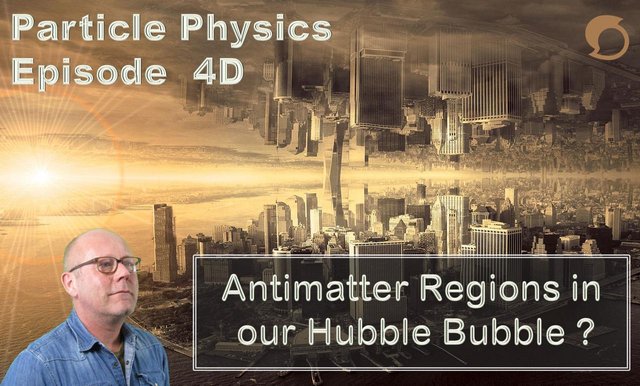
In the next two episodes, we will explore this hypothesis in detail. In a first section of this post, we will describe the concept of the Hubble Bubble, that is how to visualize what is meant by "observable universe".
In the second part of this article, we will explore the two main experimental ways to investigate the existence of space domains where antimatter is predominant.
In the next episode, we will continue our search for these antimatter regions of space beyond our observable universe. For this, we will introduce the reader to a notion from materials science, phase diagrams, and apply it to the whole Universe (including outside our Hubble Bubble).

1/ Table of content and preliminary notes
To enjoy reading this post, a prior knowledge in particle physics is not required. Yet, to fully understand all ideas presented here, feel free to brush up a little by reading the previous articles first.
- Episode 4A, “Antimatter, the mirror world” presents the fundamentals about antimatter.
- Episode 4B, “Matter and Antimatter – An Explosive Couple!” dives into the interaction of matter and anti-matter (pair production and annihilation). Appendices are included at the end of this paper if you need to brush up on particle physics fundamentals.
- Episode 4C, “The Mystery of the Missing Antimatter - an Introduction to CPT Symmetry.” goes back in time, instants after the big bang and witnesses the birth of matter and antimatter in the universe. After a description of the CPT theorem, a pillar of physics, this post discusses the link between CP violation and matter/antimatter asymmetry.
- Episode 4D, this one, defines how to visualize our observable universe (our Hubble Bubble) and presents the techniques used to detect if there are regions of space where antimatter is predominant.
- Episode 4E will draw an analogy between phase transitions in materials and those that occured in our Universe at its very beginning. This will open the door to a wild hypothesis: the existence of vast antimatter regions in our (non-observable) Universe.
Now, let’s dive in!

2/ Our Hubble Bubble
2.a - A Hubble Bubble is an observable universe
Before we begin screening the sky for signs of antimatter, let’s first define what is a Hubble Bubble.
In short, a Hubble bubble corresponds to the section of the Universe we can see. It is described by a sphere centered on the observer. For us it corresponds to the observable universe.
About 10-32s after the Big Bang, the Universe went through a huge expansion phase called inflation, where its size grew by a factor 1026 in less than 10-32 seconds! That means that in about 1 million trillion trillionth of a second, a length corresponding to the radius of an atom (0.1 nm) became a distance comparable to that between stars today.
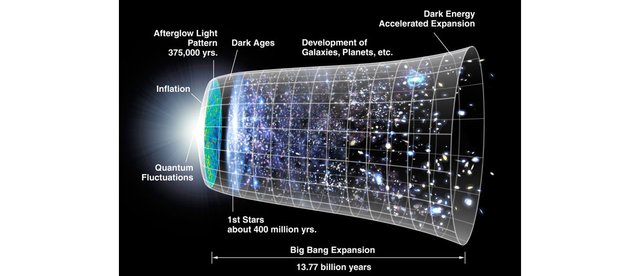
During that period, the speed of separation between two points was much larger than light (This is permitted as it is the frame of reference, i.e. space-time itself, that is extending). Inflation explains why two regions which are today causally separated look pretty much the same.
Then, when the inflation stopped, the Universe continued to expand at a much slower rate, as we can still observe now (Actually, 6 billion years ago, the expansion appears to have started to accelerate again).
What I would like to stress here, for my future arguments is that we do not know the initial size of the universe… just by how much it grew…

Let’s represent our universe as a 2-dimensional surface. The point A represents an observer located at this point (Same for B, C and D).
Let’s imagine also that at time t = 0 instant, light is freed from its interaction with matter, and all points in space suddenly emit a burst of light. This is what happened at every point of the volume of the Universe about 380000 years after the big bang when the first CMB photons were released. This instant corresponds to our time t = 0).
After 1 second, light emitted by A reaches B, located 1 light-second away (that is 300000 km). At the same time, B receives the light emitted by A: A appears in B’s sky. C or D are not visible to A, their light hasn’t reached it yet. We say that C and D are beyond A’s horizon.

After 1 minute, A will not see B anymore as the photons have passed by it 59 seconds ago (unless point B is still emitting light). Instead, A will receive the light emitted by points 1 light-minute away (about 18 million km away): C will appear in A’s sky. D is still beyond A’s horizon.

After 1 year, A will receive light from points in space located 1 light-year away: D will appear in A’s sky (and vice versa).
Quizz: When did D appear in B’s and C’s sky?
Solution: 1 year less 1 minute for C, and 1 year less 1 second for B.

What we need to remember here is that at a given time t, A will never be able to see beyond the circle described by the distance traveled by light from A since time t = 0. Such a circle describes a limit of observation for A. The surface of the circle corresponds to A’s universe: Any signal that was created on that disk at t = 0 can have been received by A. This disk is A’s Hubble Disk.
Now if we consider a three dimensional universe, the circle becomes the surface of a sphere centered at A, and the disk is now a volume corresponding to A’s observable universe also called A’s Hubble Bubble.
We, on Earth, were at a given position just an instant after the Big Bang, and because the inflation of space was faster than the speed of light, we are now at the center of an observable universe, our Hubble bubble, within a larger Universe. Every second that passes, the radius of our observable universe expands by 300000 km.
Yet in our description, we forgot something… space is still expanding… Can our Hubble Bubble keep up with the expansion of space? Let’s check this out!
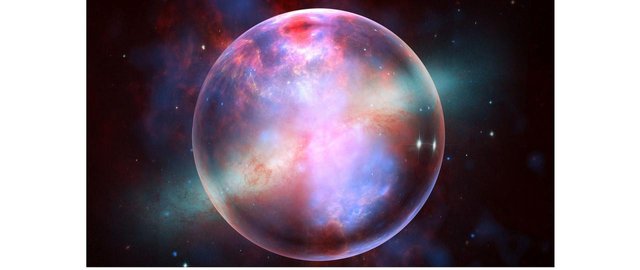
2b - The Hubble bubble cannot keep up!
Let’s go back to the 2D representation: The fabric of our two dimensional surface is expanding… That means that the further two points are, the faster they appear to be moving from each other. You can try this with a rubber band… It works!
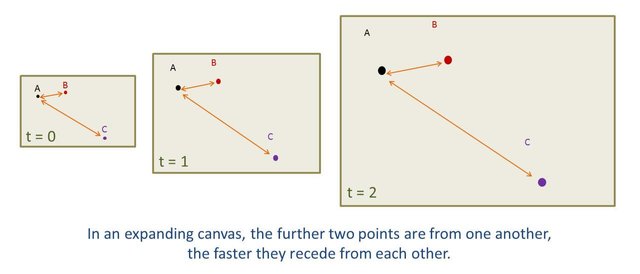
For a 3D representation, imagine the surface of a balloon on which you drew dots. When you inflate the balloon, the dots will recede away from each other. Let’s set up a central dot 'O', and observe the speed of its neighboring dots. It is easy to conceive that the further a dot is from O, the faster it recedes from it.
I tried this with a balloon:
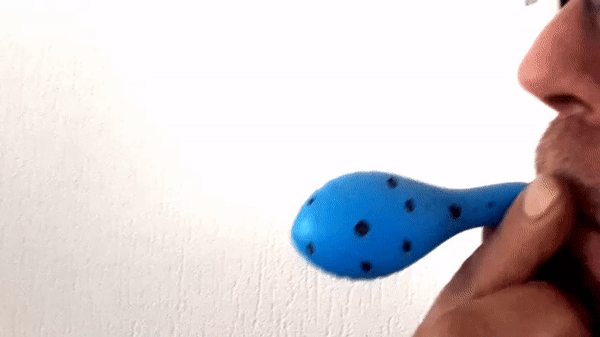
There will be a distance where two points are so far from each other, that the recession speeds will be faster than the speed of light. These objects will never be able to enter one another’s Hubble Bubble. That also means that these two observable universes will be forever disconnected causally.

2c – How large is our Hubble bubble relative to the whole Universe ?
It's summer, so some of us enjoy the long walks on the beach. Sometimes, we might stop and admire the sun when it decides to call it a day, and slides down out of our sight below the horizon. Admiring the horizon makes us realize that even though all around us appears flat, on a larger scale, we are all standing on a sphere. This is just because the human scale is considerably smaller than that of the radius of the sphere on which we live on.

The same can be said of our observable universe. By analyzing the Cosmic Background Radiation (CMB), space-time in our observable universe is measured as flat at +/- 1% (the sum of angles of a triangle is 180 degrees). If we consider our 3D Universe as the surface of a hypersphere (4D sphere), it implies that our share of the surface is just a tiny sample of reality: The observable universe is most probably extremely small compared to the Universe with a capital U.
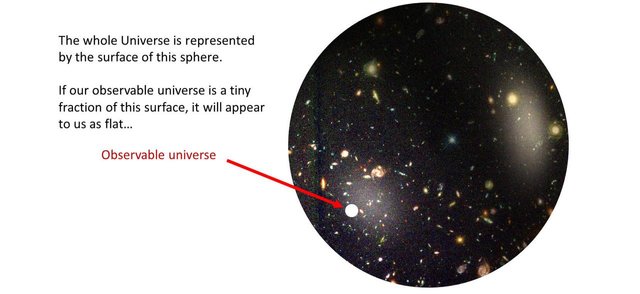
And this is where I will resume the discussion on the missing antimatter: we cannot exclude that in other regions, forever hidden from our own Hubble Bubble, antimatter is not the dominating type of matter present… Concluding that matter won over matter might just be a sampling bias that makes us try finding something (a fundamental asymmetry) that is just not there.
On a universal scale, the predominance of matter might just be an illusion, but first, let’s make sure that antimatter is not present in large amounts in our own Hubble Sphere.

3/ Are there antimatter regions in our observable universe?
3a – Chasing Gamma Flashes.
We learned in episode 4B that when matter and anti-matter particles meet, all their mass is converted to energy in the form of radiation. Such radiation is very energetic, thus is located in the gamma region of the EM spectrum.
As a reminder of the power released by such annihilation, imagine a you and an anti-you greeting each other. This would be the result:

Surely, if there were regions in our observable universe where antimatter is predominant, at the border of these domains, there would be huge explosions detectable from the largest observable distances under the form of ultra-powerful gamma ray burst.
Thankfully, we do not detect such burst in our solar system nor in the stellar neighborhood. The only gamma rays detected correspond to the 511 KeV signature of an electron-positron pair annihilation in solar flares (positrons are naturally produced by beta decay in the sun).

The same type of deduction can be made at the scale of our galaxy. Positrons are produced in stars and annihilate with electron, giving rise to many sources of the famous 511 KeV gamma radiation. Actually, it is possible to estimate that there is about one positron per one quadrillion (1015) electrons in the interstellar gas of our galaxy.
Galaxies are really far away from each other, so one could say that there could be some anti-galaxies. Still, galaxies do collide and many of these collisions can be observed. The massive amount of gamma radiation that would result from the annihilation of the matter and antimatter gas from the respective colliding galaxies has never been observed…
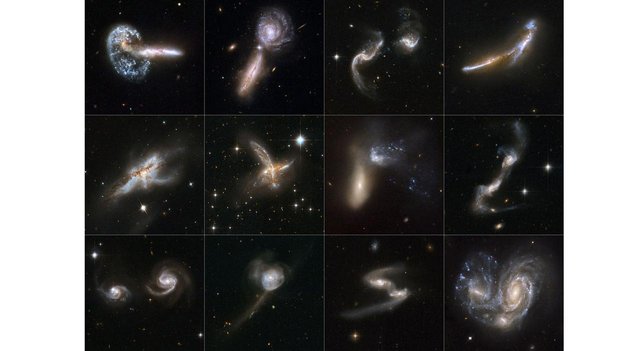
Ultra-powerful gamma-ray bursts are actually observed at huge distances (100 million – billion light years). These are now thought to find their origin in hyper-novas, black hole or neutron star collisions.
This is the scale of distance of galactic clusters of super-clusters and galactic walls. The super-clusters, separated by huge amounts of space, appear independent from each other and some could be made of antimatter. Yet, we need to rely on another technique as if the inter-cluster gas would annihilate, it would probably emit some gamma radiation background but in amounts very difficult to detect at these large distances.

3b – Chasing anti-matter atoms in cosmic rays
Our blue planet in constantly bombarded with electrons and atomic nuclei travelling close to the speed of light, and smashing into a particle of our own atmosphere. The energies involved are orders of magnitude higher than what we can produce in our most powerful accelerator (the LHC). 99% of cosmic rays are nuclei: protons (90%), heliums (9%) and heavier elements (1%). This continuous bombardment can originate from the sun, other stars, cataclysmic explosions like supernovas, pulsars, active galactic cores etc.
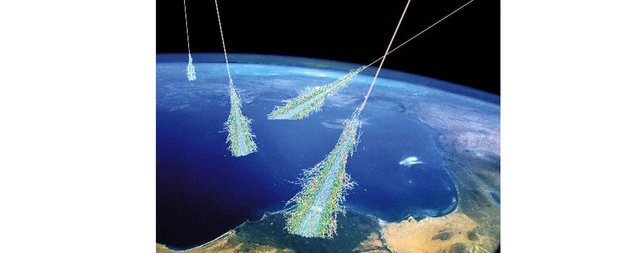
And guess what… A very small fraction of cosmic rays is composed of… antimatter (positrons and anti-protons).
If we could detect just a single an anti-carbon nucleus, that would be the proof that an antimatter star exists or existed somewhere! Such search has been carried out but no anti-helium nor anti-carbon has ever been detected, even by state of the art measurements as the Anti-alpha Magnetic Spectrometer (AMS) in place on the International Space Station. Note though, that anti-alpha particles (anti-Helium nuclei) have been produced artificially by heavy ion collisions in accelerators (more info about the AMS in this article).

3c – Verdict
Although we cannot rule out with 100% certainty the presence of vast regions of our observable universe where antimatter predominates, the likelihood of their existence is extremely small. In the neighborhood, i.e. less than 1 billion light-years away, the lack of a characteristic gamma background radiation nullifies this possibility. At further distances, if such regions did exist, we should at least have detected some hints by observing energetic antimatter nuclei in cosmic rays.
So we have to assume that the matter-antimatter asymmetry is real… as long as we consider our observable universe. But… we saw in a previous paragraph that our Hubble Bubble is most certainly small compared to the Universe with the upper limit being determined by the measurement uncertainty on the flatness of space time: Our Hubble Bubble has a radius at least 100 times smaller than that of the whole universe…
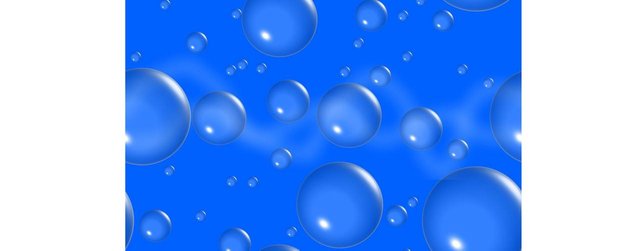
This puts a huge limit on how accurately we can describe our universe based on observation. We might be completely wrong on so many things... For example, how can we be sure that we are not in a region of low or high energy density. It looks homogeneous at the scale of 10 billion light-years… what about at the scale of a trillion light-years? Could there be structures, remnants of the pre-inflationary period, that are larger than our Hubble Bubble?
In the next episode we will dive into this idea and realize that antimatter might not be so rare after all!


The 'Particle Physics' series is aimed at providing an introduction to the world of small scale physics to non-scientists and high school students preparing for their high school exams.
Previous episodes:
- Elementary particles, the building block of reality (Particle Physics Series – Episode 1)
- Composite particles: let’s play Lego! (Particle Physics Series – Episode 2)
- Elementary fermions: the particles of matter… (Particle Physics Series – Episode 3A)
- Where does the mass of hadrons come from? (Particle Physics Series – Episode 3B)
- Let quarks be free! (Particle Physics Series – Episode 3C)
- Antimatter, The Mirror World (Particle Physics Series – Episode 4A)
- Matter and Antimatter – An Explosive Couple! (Particle Physics Series – Episode 4B)
- The Mystery of the Missing Antimatter - an Introduction to CPT Symmetry. (Particle Physics Series – Episode 4C)
Can't wait to know more?
If you can't wait to dive deep into the antimatter world, there are already some excellent articles on Steemit written by a professional particle physicist, @lemouth.
- Live from CERN - What does antimatter say when it falls?
- Live from CERN - Measuring antimatter properties with hybrid matter/antimatter atoms (without destroying the world)
- Live from CERN - ELENA is so beautiful that antimatter gets slow
- Antimatter strikes back: the CPT symmetry and the revenge of the antiproton magnetic moment at BASE (CERN)

Sources, references and to dig deeper:
- https://science.energy.gov/np/highlights/2011/np-2011-04-a/
- https://en.wikipedia.org/wiki/Chronology_of_the_universe
- https://en.wikipedia.org/wiki/Gamma-ray_burst
- https://en.wikipedia.org/wiki/Ultra-high-energy_cosmic_ray
- https://www.nasa.gov/mission_pages/station/research/experiments/742.html
- https://en.wikipedia.org/wiki/Cosmic_ray
- Book: L’anti-matiere (Gabriel Chardin)

Image credits:
- Big bang illustration (By NASA/WMAP Science Team (Original version: NASA; modified by Ryan Kaldari) [Public domain], via Wikimedia Commons (link)
- Visual element of a spherical universe, public domain, via Wikimedia Commons (link)
- Galaxy collisions: By NASA, ESA, the Hubble Heritage (STScI/AURA)-ESA/Hubble Collaboration, and A. Evans (University of Virginia, Charlottesville/NRAO/Stony Brook University), via Wikimedia Commons (link)
- Cosmic rays falling on Earth By Simon Swordy [Public domain], via Wikimedia Commons (link)
- All other pictures and visual elements are free for use commercially and were found either on Pixabay.
- Scientific illustrations and diagrams produced by @muphy.
- All illustrations, diagrams and friezes put together by @muphy using elements found on Pixabay.

Hi,
I’m @muphy (see intro post),
My life revolves around music production, teaching sciences, and discovery through travel.
You enjoyed that post? Resteem and Upvote!
You are interested in these topics? Follow me!
@muphy if we try with rubber band does it really take the shape of 2d creation ? have you tried sir? if yes can you share the image because i am bit confused about it
Hi @jaineel. You are confused... means I didn't do a good job :-(!
Let me try again :-)
I do not have a rubber band with me. I'll make a diagram for you instead :
Imagine a rubber band with 3 points, A, B and C. Points are distant from each other by 1 meter. So AB = 1m and AC = 2m. Now pull the rubber band to extend it to twice its size (The red arrow represents the pulling force). Suppose it took you 1 second to do so.
The distances are now AB = 2m and AC = 4m.
Speed is distance covered over time. Relative to A, B covered 1 m in 1 second, so its speed is 1 m/s. Still relative to A, C covered 2 meters so its speed is 2m/s.
This is because each meter of a length has increased by an extra meter every second. So if you extend a dimension of space (here the rubberband), the speed of recession of any point of that space relative to a reference will be proportional to the distance from that reference point.
In cosmology, this is referred to as Hubble’s law.
Hope it clarifies!
This makes sense @murphy
I had the same issue comprehending with a rubber band but this has clarified me.
This is a great post. The simplicity of explanation amazes me.
Whether they exist or not, matter-antimatter explosions are not what I would however want to witness. :)
I'm following you now and I hope you also follow back. :D
Me neither, check around the section of that post for some amusing calculations about that: https://steemit.com/steemstem/@muphy/matter-and-antimatter-such-an-explosive-couple-particle-physics-series-episode-4b
I checked your profile, nice scientific articles you wrote. that made me follow you, but please do not request follow backs in comment (this strategy is really for losers: rise up man!)
Another great post. One question that I have is, is the CMB supposed to be a background signal originating from the edge of the full universe?
If so does it mean that our horizon is'close' to the edge of the universe?
It's a bit mind bending so I'm not sure if my question is clear.
Thanks.
Hi there. I do understand your question, and yes it is mind bending !
The inflation of space that occurred instants after the big bang was much much faster than the speed of light. So the light emitted from a given position could only reach a small fraction of that space. It describes a sphere around that point of radius (speed of light x time).
Today, this radius increases with time, but so does space (the universe is still expanding ).
In the same way, the light that reaches that point has covered the same distance, that is the radius of the sphere. So what we see from that point is light that was emitted from the surface of that sphere.
The CMB corresponds to the limit of the volume of space we can observe, the Universe being measured 'flat' implies that this volume of space is most probably minuscule compared to the whole universe. This is actually the center of my argumentation about the potential illusion that is the matter/antimatter unbalance: we just cannot see far enough to gather enough data! Check out the next episode (it's just in my head right now, but it should be quite mind boggling too!).
I hope this clarifies things,
Be well
I think I'm starting to get the point about the CMB.
If I understand well the CMB that we observe was radiated billions of years ago.
But another civilization at the edge of our observable universe could be looking in our direction "right now" and make the same observation because the image that they would get is equally ancient.
The CMB thus shows us how the universe was like ~14bn years ago since that it the estimated distance to its source.
But if the entire universe is far greater than the observable universe, doesn't that mean that the universe could be much older than 14bn years?
In other words, how do we know that the CMB shows the state of the universe 'soon' after the big bang?
That's correct! for them, our location would be a point on their CMB!
Actually the distance of the source will be a little more due to the expansion of space in our observable universe during the 14 billion years of its existence. By taking it into account the rate of expansion (and considering it constant), it can be calculated that the radius of the observable universe is about 46 billion light years.
No, all sections of the entire Universe were born at the same time. Within the scope of eternal inflation, if two different points change state at a different time, that means that the space between these points would have inflated extremely during that time differential. These 2 points would become two different universes, completely disconnected, with maybe different values for the fundamental constants (yet, still the same laws of physics)... That is called the multiverse of level 2 - I'll probably write a series about this one day ;-). So to conclude, the entire universe in which we live in is 14 b years old.
The CMB shows the state of the universe 14 billion light years away from us (or 46 billion light years if we consider expansion), not beyond... hence my doubt about defining empirical theories on such a limited sample... It actually shows the state of that section (a surface) of the Universe 380000 years after the Big Bang...
Thanks!
no matter what the more answers we find it leads to even more question and possibilities about the universe. however, humans understanding the universe have been better than before. good post
You take your pencil, and improvise, searching for inspiration... Suddenly you find it, and it opens the doors to a brand new artistic world to explore (it does this for me when I compose in the music studio).
Well, here it is the same thing. Questions leads to research, that lead to answers. And each new answer opens a new world to explore, which provokes an avalanche of new questions!
Like in art, in science, the important is not the destination, but the journey ;-)!
Very well illustrated and perfectly argued throughout, as usual!
I enjoyed siding with whatever view you took at a given section! First I agreed with the statistical anomaly idea, then I thought the huge energy of matter/anti-matter galaxy collisions would surely be detectable, as well as anti-matter particles on Earth, and by the end I was like "we don't know, more research needed"!
It's a very clear and accessible article and that's not easy to do for physics.
EDIT: I just read this last night, and it seems the author of the book puts dark matter under the list of projects that are probably a waste of time and resources for physics!
Yes Alexander, sometimes, I have to scratch my head quite hard to find a way to present some concepts in an easy way without distorting them! Thank you very much in realizing the effort in this. I am really glad you enjoyed the read!
Be well
I'm in the same boat which is why I get it )
wow you put me to think with all the content of your post, I think I had never imagined those things.
You hit the nail.
Hi Gabriela, that's great! It is the whole idea behind the papers I write and post. If you have any questions, let me know!
When we actually see a galaxy being formed, then we will throw out the stupid idea of the big bang.
And if we do not start from the theory of the big bang, then most of the logic above falls apart.
And, when we find out that Einstein was a fraud, and E=mc2 is not correct, then so too goes out the window our idea that there should be as much anti-matter as matter.
The little bloop theory is much more elegant than all of the theorizing above.
Hey there. Why do you think the Big Bang is a stupid idea? Stuff was observed, various hypothesis were proposed and predicted some more stuff. the hypothesis for which the prediction matched the best new observations got naturally solidified. There are always dark corners, in all theories, we do not understand everything, maybe even one day, we will discover something ultra solid that will make the community
change direction. But for now, the standard model of cosmology is what works the best.
And in terms of elegance, if you look beyond the BigBang and consider it within the scope of eternal inflation, you can't make more simple and elegant than that. (the Big Bang would not be the start of reality like many people think it would - that appears absurd to me).
By curiosity, I actually tried to find a 5 minute-read summary on this little bloop theory of yours, without success.
Oh, and how can you say Einstein is a fraud, where E=mc2 has been verified literally billion of times?
The acceptance of the big bang theory was a conspiracy. Bought and paid for.
The galaxies are not spread out evenly, they are grouped very specifically. A bang does not cause that.
Galaxies themselves are spread out very specifically, not randomly.
The age of galaxies are not identical, thus hard to explain how they came from a single source.
From a spiritual / sacred geometry point of view, that is not how you create anything.
That is why i say the big bang is shtupid.
And, i feel we will get to see a galaxy being formed. After that, nix the idea completely.
E=mc2 has not been verified at all.
Look at it this way, they measured atomic explosions and then tried to figure out how many atoms where split, and then worked out that it was close...
Then you have CERN. The largest, biggest sucker of electricity on the planet. And what they are doing is taking a car apart and hurtling its pieces to find out what makes a car go. And, that is just what they are telling you. It is far easier to believe they are trying to open worm-holes or portals.
Ask yourself this. Why was CERN built where it was? It was slated to be built in Texas. If it was just about accelerating atom parts, then why wasn't Texas good enough?
And this CERN is where you get the "verified" part.
Great information as always and pretty interesting to learn some different things today :)
Thanks Blazing!
This post has been voted on by the steemstem curation team and voting trail.
There is more to SteemSTEM than just writing posts, check here for some more tips on being a community member. You can also join our discord here to get to know the rest of the community!
Nice post
Good luck
Thank you
Follow me back....